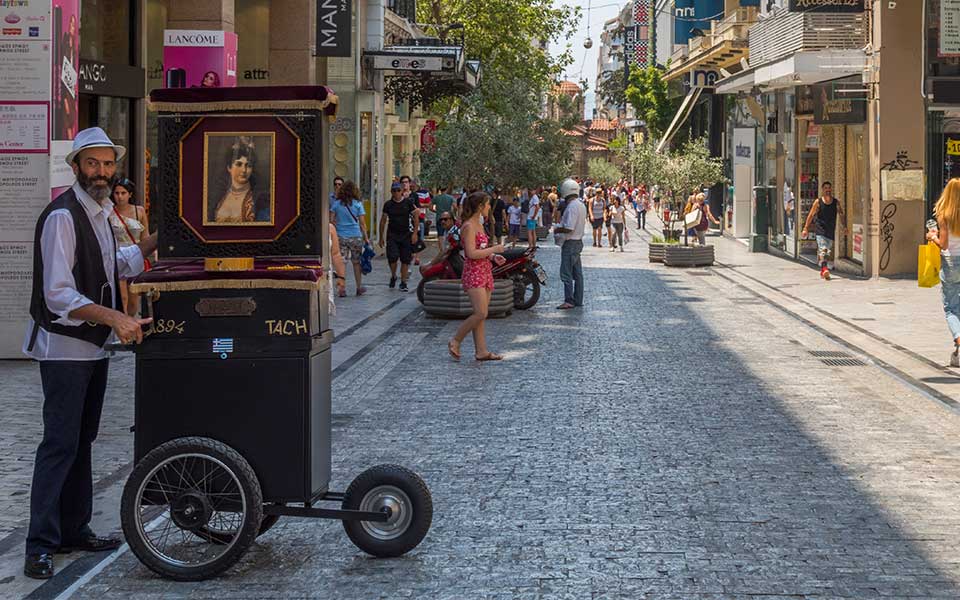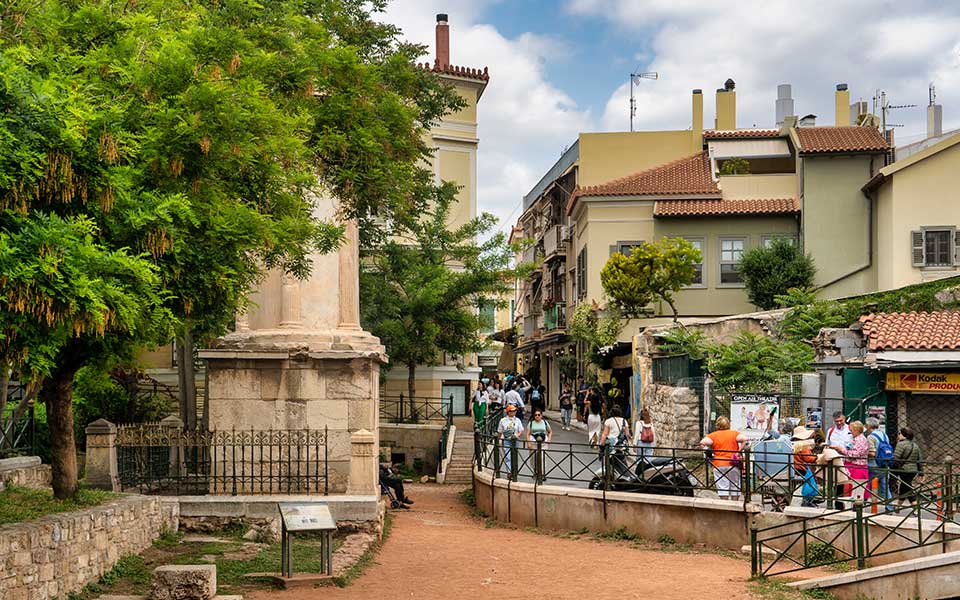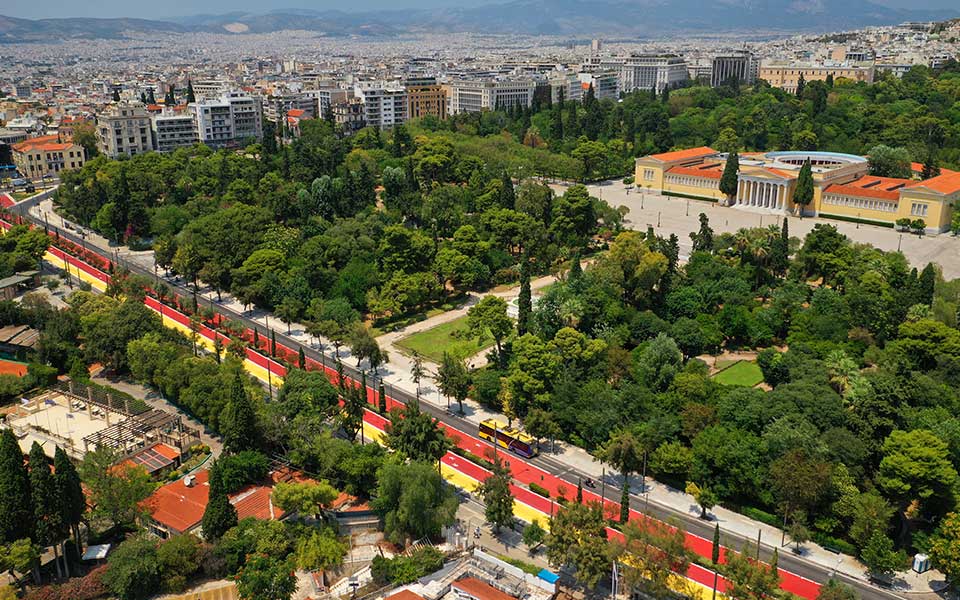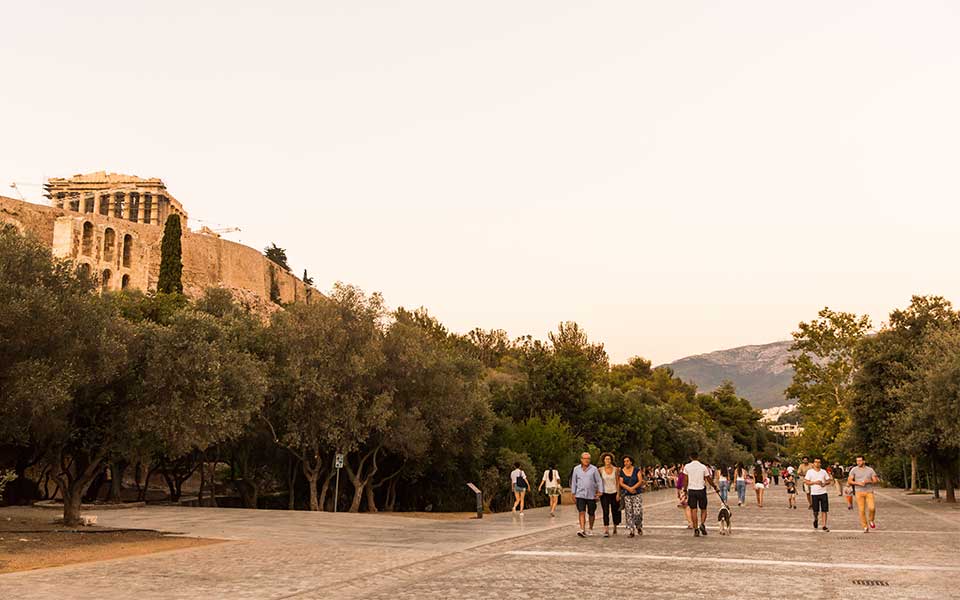Greek street names: Tracing the episodic narrative of a nation’s identity

Heroic millennia, an epic struggle for freedom, and then a brave, bold 20th century: Greece has a gripping story to tell. Its streets tell it; named for its revolutionary heroes and its poets, gods and saints, architects and queens, they do much more than honor the past. Greece’s street names are a map of the country’s spiritual identity, episodes in an engaging narrative that shapes the Greek experience in every aspect. These names of streets and town squares – “plateias” – are found all over the cities, towns, and villages of Greece. These are a few of the prominent ones.
(NB – how does Iktinus become Iktinou, Olga become Olgas, Kolokotronis become Kolokotroni, Armatoloi become Armatolon? It’s Greek grammar; in context, it’s “(the street of…) Kolokotroni: Kolokotronis in the genitive case.)
Iera Odos
Literally, the “Sacred Road” or “Sacred Way,” the Iera Odos leads from the Archaeological site of Kerameikos in Athens’ center northwest through the city, connecting eventually with the National Road that links Athens with Corinth – the road which passes through Eleusina. Ancient Greece had several Sacred Ways; generally it denoted a road for religious processions to sanctuaries or other sacred destinations. Athens’ Iera Odos lead from the Sacred Gate of the Kerameikos to Eleusia, today’s Eleusina, site of the Eleusinian Mysteries: this initiation into the cult of Persephone and Demeter was the most sacred of the secret rites of Ancient Greece.
Tripodon
The “three legs,” of the street’s name belong to the copper tripods that lined the street millennia ago. These tripods were sponsored prizes in theater competitions, for Tripodon was the street that led to the ancient Theater of Dionysus, the prototype of Greek theaters and the birthplace of drama. The classical plays we know today – works of Aeschylus, Sophocles, Euripides, Aristophanes – were first presented at the Theater of Dionysus. The tripods are long gone, but one of the more elaborate monuments, more like a small temple than a tripod, survives today. This is the Choragic Monument of Lysicrates of 335-334 BC (“cheregos” = sponsor; Lysicrates was the name of the patron who sponsored the monument), which is in its own small park on Tripodon Street, an intimate and casual archaeological site in Plaka. Athens’ Tripodon is thought to be Europe’s oldest street.
Ermou
Ermis (Hermes), son of Zeus and Maia, one of the seven sister nymphs (the Pleiades), was a worldly god; a messenger moving between the divine and mortal worlds, he’s depicted often with winged sandals. He was the patron of mortal messengers, travelers, thieves (as an infant he stole some cattle from Apollo), and, significantly, of merchants: Athens’ central shopping street is Ermou. It’s also a shopping street in Thessaloniki, in Patra, in Volos, and elsewhere throughout Greece.

Dionysos Areopagitou
The broad pedestrian street that runs along the base of the Acropolis is named for Athens’ patron saint. Dionysius the Aeropagite was a judge of the Areos Pagos (still the name of Greece’s Supreme Court of Greece today) who was converted to Christianity by Paul the Apostle – the street meets Apostolou Pavlou as it curves northward to Thisseo.
So perfectly in harmony with the landmarks around it and the land itself, this street of asymmetrical flagstone that feels as though it’s been here through the millennia is the work of architect Dimitris Pikionis, created in the 1950s.
Filikis Etairias
Initial inspiration for the War of Independence began not in Greece, but in Odesa. Here, in 1814, a secret organization was formed with the aim of overthrowing Ottoman rule to establish an independent Greek State: the Filiki Etaireia (the “Society of Friends”). The society was formed chiefly of Phanariot Greeks (a street north of Lykavittos is named Fanarioton), meaning of those of prominent and influential families of Phanar, Constantinople (today’s Fener district of Istanbul), where the Ecumenical Patriarchate of the Orthodox Church was (and is) located. The Filiki Etaireia was a secret society, in the style of the Freemasons and the Carbonari, with a strong mystical and spiritual character. The Plateia Filikis Etairias is at the heart of Kolonaki; the oath of the Filiki Etaireia is inscribed on a pillar which will return to the plateia when works there are concluded.
“I swear in the name of truth and justice, in the eyes of the almighty being, to safeguard, sacrificing even my own life, suffering even the harsh tortures of this sacrament, which will be shown to me and that I will respond the truth to whatever is asked of me.”
25 Martiou
Greek Independence Day is celebrated on the anniversary of the raising of the revolutionary flag (blessed by Palaion Patron Germanos – see below). The date coincides with the ”Evangelismos” – the Feast of the Annunciation of the Virgin. The choice of this significant date for the declaration both proclaimed the Orthodox identity of the Greeks rising up against Ottoman oppression and served to invoke the Virgin’s blessing.
The Athenian neighborhoods of Alimos, Egaleo, Kalithea, and Nikea all have a Plateia 25, Martiou. It’s also a street in Peristeri, Chalandri, and Kallithea. In Patra, it’s both a square and a street between the port and Kastro.
Didotou
The Didot family of Paris were prominent printers in the Age of Enlightenment and ardent appreciators of neoclassicism, finding in ancient Greek and Roman aesthetic philosophy the foundation of the elegance, simplicity, and mathematical precision of their own work. Firmin Didot designed a Greek typeface in 1805, which was used for the works of Adamantios Korais of the Greek Enlightenment. Ambrose Firmin Didot, grandson of Firmin, was secretary of the Philhellenic Committee in Paris. He brought both the the typeface to Greece during the Greek War of Independence and a press, donated to the revolutionary cause and used to print the newspaper Ελληνικά Χρονικά (Elliniká Chroniká), published in Missolonghi by the Swiss Philhellene Johann Jakob Meyer. It’s a doubly fitting location: along Didotou, a tree-lined street connecting Kolonaki with Exarchia, you’ll find l’Institut Français of Athens. Moreover, Exarchia is the neighborhood for independent publishing houses and small presses.

Kolokotroni
Theodoros Kolokotronis was one of the main leaders of Greece’s War of Independence. He was descended from a family of “Klephts” from the Peloponnese, and himself was initially an “Armatolos.” The word Klepht (also see Mavromichali below) translates as thief; the Klephts were rebels – brigands and highwaymen who lived with autonomy in the ostensibly Ottoman-controlled Peloponnese. The Armatoloi were Christian infantrymen hired to enforce the authority of the Ottomans. But in fact both groups were rebellious and autonomous, changing sides as occasions demanded. At the outbreak of the revolution, Kolotronis organized bands of Klephts into what became the base of the revolutionary armed forces.
Narrow Kolokotronis Street in Athens is known for its many great bars, cafés and shopping.
Armatolon kai Klefton
A small street just north of Lykavittos is dedicated to the Armatoloi and the Klephts (see Kolokotroni above, and Mavromichali below)
Mavrogenous
In the intellectual and high society circles of Trieste, the revolutionary heroine Manto Mavrogenous was known as “La Bella Greca.” Returning to Greece, based in Mykonos, she used her dowry jewels to recruit warriors, and fought on the front lines herself. She knew her way around a battlefield, but also the drawing rooms of Europe, using her society connections to raise support for the Greek cause: “To the Parisian Ladies: A plain girl, who grew up on a rock, lived in sorrow, and bustles with patriotism asks to be heard… Love of my country, devotion to my religion, and a thirst for fair revenge have stirred my soul…I long for a day of battle, as you long for the hour of a dance.”
Mavrogenous Street in Athens is a small pedestrian street near the Pedio tou Areos – the Athenian Champ du Mars – a park designed to honor the heroes of the Greek War of Independence, where you can find a bust of her, alongside those of many other heroes. Mykonos adores their heroine; she has a statue and a small plaza all her own, right beside one of the most famous waterfronts in the world.
Bouboulina
Greece’s dynamic female Greek naval commander was born Laskarina Pinotsi in Constantinople, where her father, a captain from Hydra, was in prison for his role in the Orloff revolution. When he died, she returned to Hydra, then moved to Spetses. She married sea captain Bouboulis, and when he was killed battling with Algerian pirates, she took over not just his fortune but his fleet, building the warship “Agamemnon,” one of the largest serving the Greek cause. She organized troops, and armed and fed them, ultimately (like Mavrogenous, above) exhausting her personal fortune. Under her command, the Agamemnon and its crew engaged in several successful naval blockades, reclaiming Monemvasia and Pylos.
Bouboulina’s is also among the busts in the Pedio tou Areos. Bouboulina Street in Piraeus leads to the charming Mikrolimano – “Little harbor.” In Spetses, a statue of the great heroine is the first thing you see as you pull into the harbor.
Palaion Patron Germanou
Germanos, Metropolitan of Patra and a member of the Filikis Etaireias (see above), blessed the revolutionary flag that was raised at the monastery Agia Lavra in Kalavryta in the mountains just south of Patra, signaling the beginning of the Greek War of Independence (see 25 Martiou, above). It’s a central street in Athens, near Syntagma, and also a particularly pleasant street in downtown Thessaloniki.

Mavromichali
The Mavromichali (“Black Michael”) family of the Mani peninsula was a powerful clan of several key figures in the struggle for independence. Petros “Petrobey” Mavromichalis (the “bey” of his name was a title bestowed by the Sultan) had been appointed Chieftain of Mani by the Sublime Porte. Under his command, Mani grew powerful and largely autonomous, positioning Mavromichalis to serve his ultimate goal: the overthrow of Ottoman rule. Together with his brother Konstantinos, they defeated Ibrahim Pasha and his forces.
The Mavromichali story illustrates the key role of Armatoloi and Klephts, who used their flexibility of allegiances to advantage in the fight for Greek independence. Despite his heroic role, strong differences with Greece’s first head of state, Ioannis Kapodistrias, led to Petrobey Mavromichalis’ imprisonment for treason. His son Georgios and his brother Konstantinos avenged him, assassinating Kapodistrias.
One of the most famous more recent descendants of the Mavromichalis family was the avant-garde artist Chryssa Vardea-Mavromichali, known best by her mononym, “Chryssa.”
Mavromichali Street in Athens is in the Exarchia district. In Areopoli, Mani – his hometown – he’s honored with a prominent statue and a town square in neighboring Gytheio
Amalias
Queen Amalia, wife of Otto I of Greece, arrived in Athens with a splash. She was beautiful and vivacious, and her enthusiasm for her new nation expressed itself through fashion: the ‘Amalia’ style of dress followed the lines of the era’s Beidermeier style while incorporating distinctively Greek elements – richly embroidered vests or jackets of velvet and traditional headwear. It was a sartorial expression of Greek identity, just as the Neoclassical buildings soon to fill the capital would serve as its architectural expression. Amalia also commissioned the Royal Garden, today’s National Garden, along which Amalias Street runs. Her popularity didn’t last; there was even an assassination attempt in 1861. Amid growing unpopularity (see “Γ” Septemvriou, below), Otto was deposed the following year, replaced by George I (see below). But Amalia brought her enduring love of Greece back to Bavaria; the couple was said to have continued to speak Greek each evening.
Amalias is one of Athens’ most prominent streets, running along the western edge of the National Garden from Syntagma to the Temple of Olympian Zeus.
“Γ” Septemvriou
The Greek letter “Γ” is the 3rd letter in the alphabet to indicate September 3rd. The date marks an uprising of 1843 against the autocratic rule of King Otto of Bavaria, which led to the drafting of the first constitution after the founding of independent Greece. King Otto was finally deposed in 1862 after a series of popular insurrections, replaced by George, born a Danish Prince of the house of Schleswig-Holstein-Sonderburg-Glücksburg; his rule would prove long and successful, despite its tragic end (see Vasilissis Georgiou, below).
Γ Septemvriou runs from Patision district to Omonia Square.
Vasilissis Georgiou / Vasilissis Olgas
During the reign of George I, which was but days shy of half a century (March 30, 1863 – March 18, 1913), the new Greek State flourished. Substantial territorial gains for Greece included the Ionian Islands (in 1864), Thessaly and the Arta Prefecture (1881), and Epirus, Macedonia, and many of the islands of the Aegean (1912). The Olympic Games were reinstated, the Archaeological Museum was constructed, and the Corinth Canal opened. The king’s marriage to Olga Constantinova also proclaimed the Orthodox identity of modern Greece.
Greece’s liberation of Thessaloniki (see 26 Octovriou, below) was not celebrated by all; Bulgaria had been en route to the city when the Greek Army took it over. Moreover, the newly Greek Thessaloniki didn’t receive the the Great Powers’ enthusiastic support (international elite enjoyed privileges under the Ottomans). To emphasize Greece’s claim, the Royal Family moved en masse from Athens, living in various mansions in the “Exoches” – the seaside district along what in the Ottoman era had been called the Hamidiye (for Sultan Abdul Hamid II). Today, this boulevard is named Vasilissis Olgas up to the point where king George was assassinated with a shot to the heart, then it continues in the name of King George – Vasilissis Georgiou – as it leads to the center of town. Statues of both king George and queen Olga mark the spot. In Athens, Vasilissis Georgiou is among the most prominent streets of the center, forming the northern boundary of Syntagma Square, with the Grande Bretagne its most famous building.
26 Oktovriou
October 26th is the Feast Day of Thessaloniki’s patron Saint Dimitrios, the focal point of fall. In addition to the pilgrimages to the Church of Saint Demetrius, October 26th is also the day that the Greek Army took the city in the course of the successful first Balkan War, in 1912. The handover, from Ottoman General Hasan Tahsin Pasha to Crown Prince Konstantine (son of king George), was peaceful; the Greek Army had just days before taken the last line of Ottoman defense near the city, the fortress at Giannitson.
In Thessaloniki, 26. Oktovriou Street runs from the courthouse to the west alongside the commercial port.
Emmanouil Benaki
It’s difficult to imagine the culture of contemporary Athens without the name Benaki. The Benaki organization has several of the city’s key museums, among them the Benaki Museum of Greek Culture, Pireos 138, the Museum of Islamic Art, and the Ghika Gallery. The organization was started by Antonis Benakis, whose collections of Greek and Islamic Art were initially housed in the main building. Emmanouil Benakis, his father, was a prominent benefactor of Greece who had been successful in the cotton industry in Alexandria, Egypt, before returning to Greece where he served as Minister of Agriculture and Industry in the government of Eleftherios Venizelos, and also as mayor of Athens.
Benaki is one of Exarchia’s main streets.

Kountouriotou
Admiral Pavlos Kountouriotis, of a shipping family of Hydra, participated in naval operations in the Greco-Turkish war and the Cretan revolt in the late 19th century, then played an essential role during the Balkan Wars and WWI. Greece had two key victories with Kountouriotis as captain of the Averoff: the Battle of Elli and the Battle of Lemnos, gaining Greece control of most of the Aegean Islands. During WWI, he formed part of the Triumvirate of the Provisional Government of National Defense with Prime Minister Venizelos and General Daglis. Greece’s entry into WWI involved a National Schism: Prime Minister Venizelos supported entering on the side of the Entente, seeking both territorial gains in Asia Minor – the realization of the “Great Idea” – and to support Greece’s ally Serbia. King Konstantine (see 26 Oktovriou above), brother in law to Kaiser Wilhelm, favored neutrality.
In Athens, Kountouriotou Street in Exarchia leads to the back of the National Archaeological Museum. In Piraeus, it is one of the streets leading to the Mikrolimano (see Bouboulina, above).
28 Oktovriou
The 28th of October is “Ochi” (OXI) Day – the word on patriotic banners reflects the terse response of Prime Minister Ioannis Metaxas to Benito Mussolini’s request to enter Greece, on October 28, 1940: “No.” The Italians entered anyway, an invasion met with such tenacious resistance they were repelled. Later, the Germans arrived in force. The bravery and skill of Greek resistance during the occupation was a source of profound inspiration to all of its allies, and even won them the admiration of their invaders.
28 Oktovriou is a prominent thoroughfare running from Patision to Omonia Square.
Plateia Tsitsanis
The legendary bouzouki player Vasillis Tsitsanis, born in Trikala in 1915, was already playing in tavernas in Athens in his late teens. He met the singer Dimitris Perdikopoulos, who introduced him to Columbia records, and he was soon recording. When he moved to Thessaloniki during the German occupation, he had already started playing Rebetika – the urban Greek blues introduced by the refugees from Asia Minor. The genre was marginalized, nearly banned, during the dictatorship of Ioannis Metaxas (see 28 Oktovriou, above), who was against anything eastern, which only strengthened Tsitsanis’ commitment to it. Nearly anthemic among his many songs is the classic “Synefiasmeni Kyriaki” (Cloudy Sunday).
The Plateia Tsitsanis is in Thessaloniki’s Ano Poli, close to the Gedi Koule prison, associated with the marginalized genre, where many a Rebetiko song was played.
Octave Merlier
Behind the Institut Français is a street named for the institute’s director from 1938-1961, spanning WWII and the events that followed. Merlier had met the musicologist and folklorist Melpo Logotheti at the Sorbonne, and they married. Early in his tenure in Athens, the Merliers were members of the Greek resistance in WWII, and he served as a secret agent for Charles de Gaul. The Germans occupied Athens in April of 1941; Merlier was captured and recalled to France by the Vichy government. The Merliers spent three years in France; when they returned to Athens the civil war had begun. Together with Roger Milliex, the institute’s general secretary who shared the Merliers’ leftist orientation, the Merliers organized an exodus of 200 young artists and intellectuals in 1945 on the Mataroa, which departed from Piraeus and docked in Taranto, from where they continued to Paris. The Mataroa is well-known in Greece – the name itself is associated with an arc of artistic and intellectual freedom both historic and symbolic.
The Streets of Greece
En route to dinner and drinks, the “therina” (summer, outdoor) cinema, or an early morning visit to the Parthenon, you’ll be walking along many more of these flowing monuments, random snapshots of intriguing protagonists and events. Like Merlier here above, they may be obscure for many, but for that they have a story all the more interesting; taking a photo of a street name to look up later lets you enjoy the walk.
This article first appeared in Greece Is (www.greece-is.com), a Kathimerini publishing initiative.





